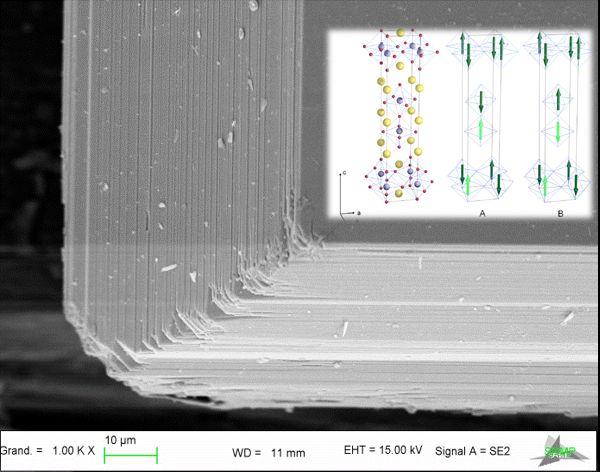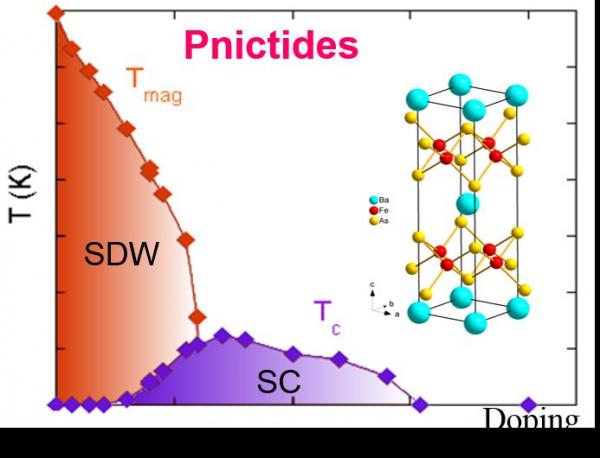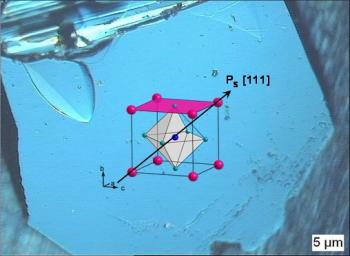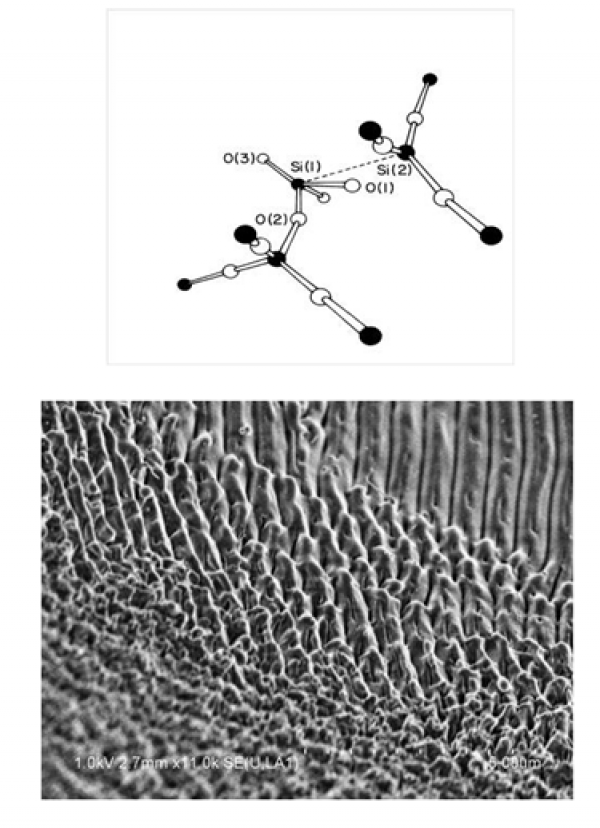Pages scientifiques 2016
The iridates (eg Sr2IrO4, Sr3Ir2O7 ...) have recently attracted the attention of the scientific community due to the presence of a strong spin-orbit coupling and strong electronic interactions that give rise to original physical properties as the high Tc superconductivity or the state of topological insulator. We explore in detail the impact of a strong spin-orbit coupling in these compounds by synthesizing single crystals with a method of self-flow and thin films by PLD technique and by studying the magnetic and transport properties of these oxides.
On these issues, the group has developed national and international collaborations in particular with: LPS-Orsay; Soleil; MPQ-Paris7; LLB-Saclay ;
Contact CEA-IRAMIS/SPEC : Dorothée Colson (SPEC/LNO)
Projects: SOCRATE (ANR 2015-2019)
Superconductivity is a fascinating state of matter in which electric current flows without dissipation of energy. For thirty years, the search for high-temperature superconductors focused on cuprates, however, the origin of the pairing mechanism is not yet clear because of the high structural and electronic complexity of these materials. To study the properties of high Tc superconductors, the sample quality is a crucial element. One of the strengths of the group is to be able to implement various advanced techniques to synthesize ceramics or single crystals cuprates, including mercury cuprates of the highest Tc of (135K, or -138 ° C) at ambient pressure but also new iron pnictides. These pure or substituted compounds, including cuprates are actively elaborated and studied to capture the main features of the electron pairing mechanism.
On these issues, the group has developed national and international collaborations in particular with: LPS-Orsay; Soleil; MPQ-Paris7; ESPCI-Paris; LSI-Palaiseau; ESRF-Grenoble; Institut Néel-Grenoble; Université de Sherbrooke (Canada); IFW Dresden (Allemagne); Université de Victoria (Nouvelle Zélande)…
Contact: Dorothée Colson
Regarding multiferroic oxides, the group has developed very resistive crystals that have enabled to demonstrate, for the first time, the multiferroic character at room temperature of the BiFeO3 compound and determine a very high electric polarization value (P> 100 μC / cm 2 >> 25 μC / cm2, reference value of the barium titanate, ferroelectric BaTiO3). In collaboration, a coupling between magnetism and electric polarization at room temperature was highlighted as well as other properties quite amazing as the coupling between light and deformation etc... [cf. publications + faits marquants]… Because of these couplings, this type of multifunctional materials offer the ability to switch, under the action of an external signal of a particular kind (light, stress, external magnetic field or electric), property of different type of material (magnetization, electric polarization, deformation ...). All these couplings in the same material, opens the way to designing a wide variety of sensors with amazing potential applications.
On these issues, the group has developed national and international collaborations in particular with: LPS-Orsay; Soleil; MPQ-Paris7; LLB-Saclay ; UMR-Thalès-Palaiseau ; IPCMS Strasbourg…
Contact: Dorothée Colson
Solar energy conversion is today a fact. Traditionally dominated by crystalline silicone, new alternative technologies are emerging, in particular based on organic photovoltaics (OPV), hybrid solar cells (dye-sensitized solar cells) or new inorganic materials such as perovskites and nanomaterials. The efficiency of a photo-active material depends on the charge separation process that is itself largely dependent on the structural properties of the material. Charge carriers can be trapped and other competing non-radiative relaxation processes may decrease the efficiency. The initial processes preceding the charge separation are studied in DICO using time-resolved spectroscopy.
This topic is being developed in two directions :
2. Hybrid organic-inorganic structures
Dye Sensitized Solar Cells, also known as Grätzel cells, are very promising owing to their potential efficiency as well as being cheap. However, further improvements are necessary, particularly on the photocathode side. This requires a more detailed understanding of the molecular and electronic dynamics. To this purpose we have undertaken a study of the photophysics and the primary processes occurring after light absorption using femtosecond luminescence up-conversion (project funded by the CEA programme DSM Energy).
A PhD student, Valentin Maffeis, co-directed by Drs. Thomas Gustavsson and Bruno Jousselme (DRF/IRAMIS/NIMBE/LICSEN) is working on this subject (2015-2018).
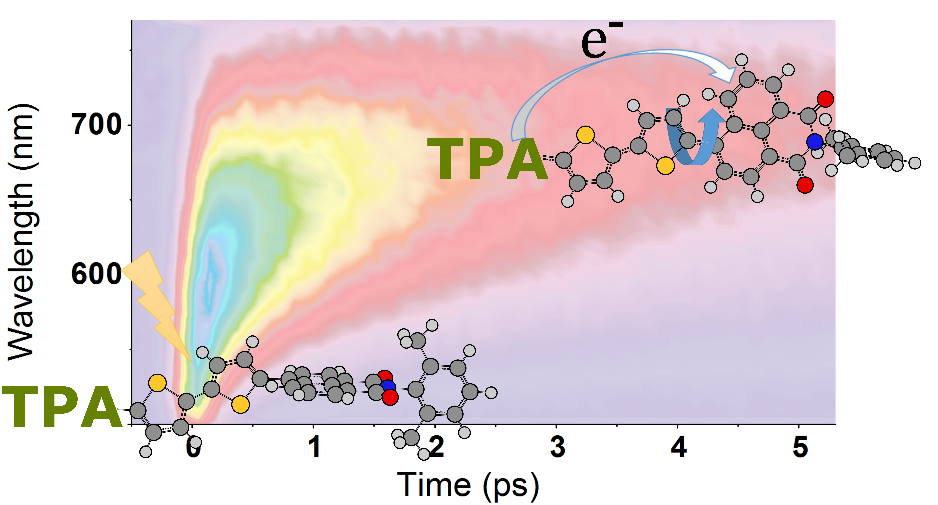
Figure 1. Time-resolved fluorescence spectra of a new push-pull type molecule I solution. The excited charge transfer state formed by light absorption is strongly stabilized by the polar environment. The charge separation (and ultimately, the charge injection) occurring in the excited state is in dynamic competition with the energy stabilization which leads towards a non-radiative internal conversion (leading to electron back transfer). It is therefore important to characterize the different processes involved in order to optimize the "wanted" reaction paths (charge separation) with regards to the "unwanted" reaction paths (internal conversion).
Hybrid organic-inorganic structures are a new class of materials that combine the advantages of organic and inorganic systems. Among these materials, hybrid perovskites are currently attracting an enormous interest. This new research program aims to examine in detail the ultrafast photophysical processes occurring in hybrid perovskites using the combination of femtosecond luminescence up-conversion and two-dimensional (2D) electronic spectroscopy. This project is supported by an ANR ACHN grant (2016-2019) coordinated by Elsa Cassette.
A PhD student, Carolina Villamil-Franco, co-directed by Drs. Thomas Gustavsson and Elsa Cassette is working on this subject (2017-2020).
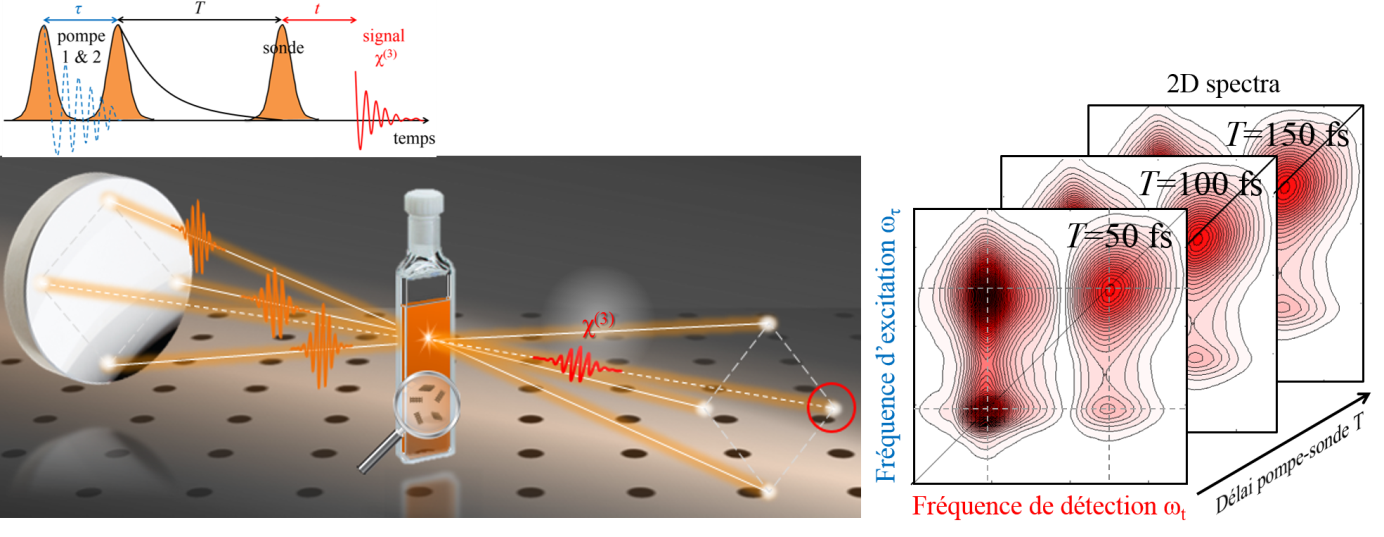
Figure 2. Principle and schematic view of a two-dimensional (2D) electronic spectroscopy measurement in the "boxcar" configuration. Also shown are typical "2D-plots" correlating the excitation and detection frequencies, showing the presence of off-diagonal coupling terms.
Nous étudions les processus d’excitation et de relaxation électronique dans les solides excités par une impulsion laser ultra-courte et intense.
Les matériaux étudiés sont essentiellement les diélectriques à large bande interdite, soit pour leur importance dans les applications telle que l’optique ou l’électronique (SiO2, Al2O3, Diamant, MgO, CdWO4), soit pour leur intérêt fondamental (Diamant, Halogénures d’alcalins).
Les processus physiques étudiés vont de la formation des défauts ponctuels, au claquage optique, en passant par les effets de forte densité d’excitation tels que l’interaction entre excitons dans les scintillateurs.
Approche expérimentale : suivre l’évolution de la matière en temps réel
Les lasers délivrant des impulsions ultra brèves sont un outil expérimental unique pour étudier les solides. Ils présentent un double intérêt :
- générer une forte densité d’excitation dans les solides, de façon contrôlée,
- permettre les expériences résolues en temps de type pompe et sonde avec différentes techniques de diagnostique : interférométrie, absorption, réflectivité, photoémission à deux impulsions, etc…, et ainsi résoudre la dynamique des processus d’excitation et de relaxation.
Des défauts ponctuels au claquage optique : suivant les éclairements utilisés, les lasers femtosecondes permettent d’étudier une large gamme de phénomènes, qui vont de la formation des défauts ponctuels : à gauche, modèle d’exciton auto piégé dans le quartz, jusqu’au claquage optique : ici image MEB d’un cratère d’ablation dans α-SiO2.
La résistance des structures métalliques à la corrosion à très long terme en milieu anoxique est un sujet d’étude important dans un double contexte. D’une part, en France, il est prévu de stocker les déchets radioactifs HA et MA-VL à 500m de profondeur au sein d’une couche d’argilite naturelle. Un système multi-barrières notamment composé de structures en acier non ou faiblement allié (chemisage et colis) doit permettre le confinement des rayonnements ionisants sur des durées pluriséculaires. D’autre part, les processus de corrosion anoxique sont étudiés dans le cadre de la conservation de mobiliers archéologiques ferreux « in situ », c’est-à-dire dans leur milieu d’enfouissement actuel tel que cela se pratique dans certaines conditions de conservation (tourbières ou sites lacustres).
Or, la présence de micro-organismes dans le système de corrosion d’objets ferreux enfouis en conditions anoxiques est susceptible d’entraîner des modifications dans les processus de corrosion qui les dégradent. L’un des axes de recherche mené au laboratoire s’intéresse plus particulièrement aux bactéries sulphato-réductrices (BSR). Ces organismes sont capables de réduire les sulfates du milieu en sulfures ce qui peut entraîner la précipitation de sulfures de fer et donc la modification des processus de corrosion. Afin d’appréhender les processus de corrosion ayant lieu, il est donc impératif de pouvoir détecter l’intervention potentielle de bactéries dans les mécanismes de corrosion sur le très long terme. C’est pourquoi une méthode de détermination de l’origine bactérienne des sulfures de fer contenus dans les couches de produits de corrosion formés sur des objets archéologiques corrodés sur plusieurs centaines d’années en milieu anoxique est développée dans le cadre de cette étude à l’aide de mesures isotopiques.
Permanents impliqués : Florence Mercier-Bion, Delphine Neff, Eddy Foy, Jean-Paul Gallien, Enrique Vega, Philippe Dillmann.
Collaboration :
- IRSN, Fontenay-aux-Roses, France
- IPREM UMR 5254, Equipe Environnement et Microbiologie, IBEAS, F-64013 Pau, France
- NIMBE/LAPA, Cea-CNRS CEA Saclay, France
According to the French concept for deep geological disposal, high level radioactive waste will be emplaced in carbon-steel overpacks in a host rock consisting in a Callovo-Oxfordian clayey formation located in the Eastern Paris Basin. These overpacks have to ensure containment for several hundred years. During the first years after closure, they will be in unsaturated and aerated conditions and after a transition period aerated/deaerated the system would be in anaerobiosis. The study presented here is a part of a collaboration between LAPA and the French Institute of Radioprotection and Nuclear Safety (IRSN) in Fontenay-aux-Roses in France. IRSN has been conducting researches in its Tournemire Underground Research Laboratory (URL), a railway tunnel which crosses a Toarcian argillaceous formation. This geological layer is particularly interesting for its physical and chemical properties close to those of the Callovo-Oxfordian formation.
An original corrosion set-up was carried out: steel coupons were placed in drilled argillite with flowing of Tournemire pore water either in absence or in presence of a bacterial strains mix, at various temperatures, in oxic or anoxic conditions, and during one, four or nine months. The aerated conditions were chosen to understand what could take place at the beginning of the storage of the nuclear waste before the anoxic phasis. The mix of bacterial strains is representative of those reported in studies of the deep clayey biodiversity: Sulphate-Reducing Bacteria (SRB), Sulfur-Oxidizing Bacteria (SOB), Iron-Reducing Bacteria (IRB), biofilm forming strains. After the corrosion experiment, the steel coupons (surface and polished transverse sections) were characterized by complementary techniques: µRaman spectroscopy and XRD, so as to identify the crystalline structure of the corrosion products and FESEM at low voltage (5 kV) to evidence bacteria and biofilms and their association to the corrosion products. The bacterial diversity on the surface of steel coupons was also characterized by DNA Preparation and sequencing at IPREM (Equipe Environnement et Microbiologie). The corrosion rate was also determined for all the coupons.
The aim of this study is to determine the bacterial impacts on steel corrosion in conditions prevailing in a repository in the presence of a complex biodiversity with the following questions:
- are biofilms formed onto the steel surface?
- do the added bacteria change the nature of the corrosion products? of the corrosion rate ?...











